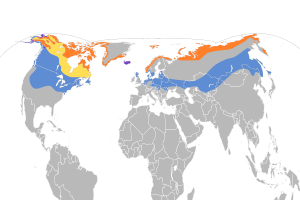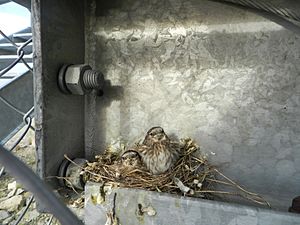Snow bunting facts for kids
Quick facts for kids Snow bunting |
|
|---|---|
 |
|
| Male in breeding plumage, Alaska | |
| Conservation status | |
| Scientific classification | |
| Genus: |
Plectrophenax
|
| Species: |
nivalis
|
 |
|
| Synonyms | |
|
|
The snow bunting (Plectrophenax nivalis) is a type of passerine bird. It belongs to the family called Calcariidae. This bird is special because it lives in the Arctic all around the North Pole. You can find it breeding in the northern parts of the world.
Sometimes, small groups of snow buntings live on high mountain tops south of the Arctic. These places include the Cairngorms in Scotland and the Saint Elias Mountains near the Alaska-Yukon border. The snow bunting is known for living further north than any other small songbird in the world.
Contents
What Does a Snow Bunting Look Like?

The snow bunting is a medium-sized passerine bird. Males and females look different, which is called sexual dimorphism. This bird spends a lot of time on the ground. It walks, runs, and can even jump if it needs to.
Snow buntings are quite large for a bunting and have long wings. They are about 15 cm (6 inches) long. Their wings can spread from 32 to 38 cm (12.5 to 15 inches) wide. They weigh between 30 and 40 grams. Their beak is yellow with a black tip. In summer, the male's beak turns completely black.
Their feathers are white on their belly. Their wings and back have black and white patterns. Males and females have different feather colors. During the breeding season, the male is mostly white with black wingtips and a black back. The female has black wingtips and a reddish-brown back. In winter, both males and females have more reddish-brown on their backs.
In spring, snow buntings do not molt (shed their feathers) like many other birds. Instead, their breeding colors appear as their old feathers wear away. Unlike most small songbirds, the snow bunting has feathers on its legs and feet. This helps it survive in its cold home. Only the common raven can spend the winter as far north as the snow bunting.
People sometimes confuse the snow bunting with the McKay's bunting because they look very similar. It can be even harder to tell them apart when they breed together where their territories meet. Another similar bird is the horned lark, but it has a larger black tail and a smaller white patch on its wings.
Snow Bunting Family Tree
The snow bunting used to be part of the Emberizidae family. This family includes American sparrows, buntings, towhees, and finches. Now, the snow bunting is in the family called Calcariidae, which also has longspurs.
The name Plectrophenax comes from Ancient Greek words meaning "cock's spur" and "imposter." The word nivalis is Latin for "snow-white."
There are four main types (called subspecies) of snow buntings. They look a little different in their feather patterns, especially the breeding males:
- Plectrophenax nivalis nivalis: Found in Arctic Europe and North America. It has a white head and mostly black rump with a small white area.
- Plectrophenax nivalis insulae: Found in Iceland, the Faroe Islands, and Scotland. It has a white head with a black collar and a black rump.
- Plectrophenax nivalis vlasowae: Found in Arctic Asia. It has a white head and mostly white rump.
- Plectrophenax nivalis townsendi: Found in the Aleutian Islands, Kamchatka, and coastal eastern Siberia. It looks like vlasowae but is a bit bigger.
The snow bunting is very closely related to the McKay's bunting. McKay's buntings have even more white feathers. Sometimes, these two species breed together in Alaska.
Snow buntings have also been known to breed with Lapland Longspurs. The first pictures of this type of hybrid bird were taken in April 2011.
Where Snow Buntings Live
Snow buntings live in the very cold Arctic tundra. There is no clear northern limit to where they can live. However, how far south they live depends on how long the daylight lasts, which affects their breeding.
You can find this bird in the high Arctic tundra of North America, Ellesmere Island, Iceland, and the mountains of Scotland, Norway, Russia, North Greenland, Siberia, Novaya Zemlya, and Franz Josef Land.
In winter, these birds fly south to cooler northern areas. These areas include southern Canada, the northern United States, northern Germany, Poland, Ukraine, and parts of central Asia. During the last ice age, snow buntings lived all over Europe.
During the breeding season, snow buntings look for rocky places in the Arctic. The plants in the tundra are very short, so the birds and their nests are open to predators. To keep their offspring safe, snow buntings build their nests in cracks and holes in rocks. This protects the young birds from dangers.
During this time, buntings also look for places with lots of plants. These include wet sedge meadows and areas with dryas and lichens. In winter, they look for open areas like farms and fields. Here, they eat seeds from the ground.
How Snow Buntings Travel
Snow buntings migrate to the Arctic to have their young. They are the first migrant birds to arrive in these cold places. Before they migrate, they need to gain at least 30% of their body weight.
The males arrive first, usually at the beginning of April. The temperature can be as low as -30 degrees Celsius then! They arrive early because they are very protective of their nesting areas. A good nesting spot is very important for them to have successful young. Females arrive four to six weeks later, when the snow starts to melt.
Snow buntings usually migrate in small groups. They fly with an up-and-down motion at a medium height.
These passerine birds spend the winter in northern areas with open fields. They form moving flocks. They leave the Arctic in mid to late September, though some might start migrating in early November. Females usually leave first and spend the winter further south than the males. Young birds leave the Arctic even later than the adults.
Snow buntings migrate at night. They can sense the Earth's magnetic field to help them find their way. This helps them guide themselves to their breeding and winter homes. They do not need to see anything to know which way to go. Studies show that only birds with enough energy stored can choose the right direction for their migration.
Snow Bunting Behavior
What Snow Buntings Eat
From fall to spring, snow buntings eat many kinds of weed seeds. These include knotweed, ragweed, amaranth, goosefoot, aster, and goldenrod. They also eat different types of grass seeds. During this time, they search for food in the snow, picking seeds from lower plant stems.
In summer, their diet changes. They eat seeds from plants like crowberry, bilberry, bistort, dock, poppy, and purple saxifrage. They also eat invertebrates (bugs) like butterflies, true bugs, flies, wasps, and spiders. Baby snow buntings (nestlings) eat only bugs. Snow buntings also hunt spiders by throwing small rocks around them. Sometimes, they try to catch bugs while they are flying.
How Snow Buntings Communicate
Snow buntings make a special whistling sound, like "per,r,r,rit." Their typical song is a warble that sounds like "hudidi feet feet feew hudidi."
Snow buntings use sounds to talk to each other. Males also sing to attract females. Both males and females make calls when they are flying or on the ground. Males often sing from a high spot or while flying in a special display.
Males start singing as soon as they reach their breeding grounds. They stop singing once they find a mate. Studies show that how well and how often a male sings affects his chances of having young. A male who sings more often shows that he is good at finding food. This is important because a male who can find food well will be able to feed his young better. Females often choose their mates based on how much they sing.
Each male snow bunting has a unique song. This means they can recognize each other by their songs. Their songs are about 2 seconds long and have a frequency of 2 to 6 kHz. Each song has different parts that repeat and change, making each male's song special.
Reproduction and Life Cycle
Snow buntings usually have one mate for the breeding season (this is called monogamous behavior). The male helps the female a lot with raising the young. The male follows the female during her fertile period to make sure she doesn't mate with other males.
Nesting in rock cracks and holes keeps the young safe, but it can also be very cold. The low temperatures might make the eggs take longer to hatch or even harm the embryo. To help with this, the male brings food to the female while she is sitting on the eggs. This way, she can stay on the nest and keep the eggs warm. This helps more eggs hatch and makes the incubation time shorter.
This passerine bird lays eggs as soon as the temperature is above 0 degrees Celsius. The eggs are blue-green with brown spots. They hatch in 12–13 days. The young birds are ready to fly after another 12–14 days.
Courtship Behavior
The way snow buntings court each other can be different in various parts of the world. In Greenland, the male will perform a threat display to protect his territory. He will make very loud calls, lower his head, and turn to face any bird that comes too close.
Males also perform a special flight to attract females. They fly up to 30 to 50 feet high, then glide down. While gliding, they sing their song very loudly. They then continue singing from a resting spot.
Climate Change and Snow Buntings
There are signs that climate change could have a big effect on snow bunting populations. The Arctic oscillation index (AO) is a way to measure climate in the Arctic. When the AO index is positive, it means warmer winter temperatures and more snow. It also means earlier and warmer springs, but cloudy, humid, and cooler summers.
The AO index usually goes back and forth between positive and negative. However, for the last 40 years, it has mostly stayed in the positive phase. Studies show that warmer springs make snow buntings start breeding earlier. This can cause problems because their food sources might not be ready yet. This mismatch can lead to fewer young birds surviving.
Also, warmer temperatures might bring other bird species to the Arctic. These new species could compete with the snow bunting for food and nesting spots. Some people also think that warmer temperatures might help snow buntings have a second group of young birds in one season.
Gallery
See also
 In Spanish: Escribano nival para niños
In Spanish: Escribano nival para niños












